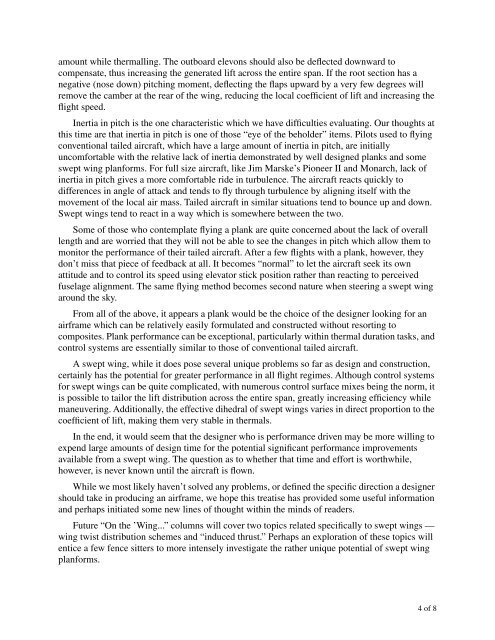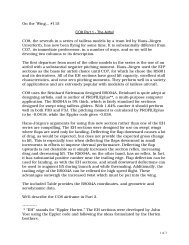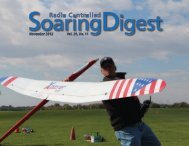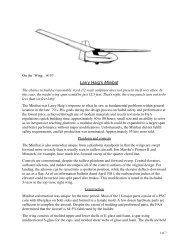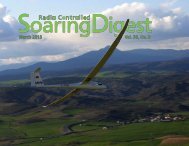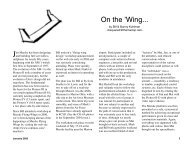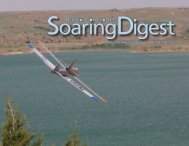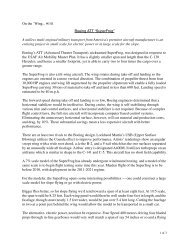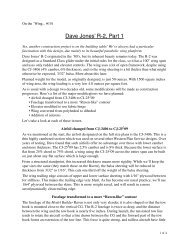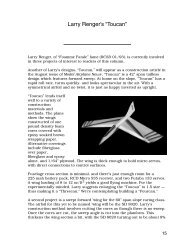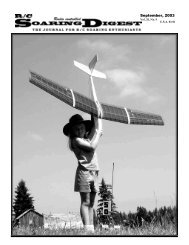160 Plank vs Sweptcomplete.FM5 - Radio Controlled Soaring Digest
160 Plank vs Sweptcomplete.FM5 - Radio Controlled Soaring Digest
160 Plank vs Sweptcomplete.FM5 - Radio Controlled Soaring Digest
You also want an ePaper? Increase the reach of your titles
YUMPU automatically turns print PDFs into web optimized ePapers that Google loves.
amount while thermalling. The outboard elevons should also be deflected downward tocompensate, thus increasing the generated lift across the entire span. If the root section has anegative (nose down) pitching moment, deflecting the flaps upward by a very few degrees willremove the camber at the rear of the wing, reducing the local coefficient of lift and increasing theflight speed.Inertia in pitch is the one characteristic which we have difficulties evaluating. Our thoughts atthis time are that inertia in pitch is one of those “eye of the beholder” items. Pilots used to flyingconventional tailed aircraft, which have a large amount of inertia in pitch, are initiallyuncomfortable with the relative lack of inertia demonstrated by well designed planks and someswept wing planforms. For full size aircraft, like Jim Marske’s Pioneer II and Monarch, lack ofinertia in pitch gives a more comfortable ride in turbulence. The aircraft reacts quickly todifferences in angle of attack and tends to fly through turbulence by aligning itself with themovement of the local air mass. Tailed aircraft in similar situations tend to bounce up and down.Swept wings tend to react in a way which is somewhere between the two.Some of those who contemplate flying a plank are quite concerned about the lack of overalllength and are worried that they will not be able to see the changes in pitch which allow them tomonitor the performance of their tailed aircraft. After a few flights with a plank, however, theydon’t miss that piece of feedback at all. It becomes “normal” to let the aircraft seek its ownattitude and to control its speed using elevator stick position rather than reacting to perceivedfuselage alignment. The same flying method becomes second nature when steering a swept wingaround the sky.From all of the above, it appears a plank would be the choice of the designer looking for anairframe which can be relatively easily formulated and constructed without resorting tocomposites. <strong>Plank</strong> performance can be exceptional, particularly within thermal duration tasks, andcontrol systems are essentially similar to those of conventional tailed aircraft.A swept wing, while it does pose several unique problems so far as design and construction,certainly has the potential for greater performance in all flight regimes. Although control systemsfor swept wings can be quite complicated, with numerous control surface mixes being the norm, itis possible to tailor the lift distribution across the entire span, greatly increasing efficiency whilemaneuvering. Additionally, the effective dihedral of swept wings varies in direct proportion to thecoefficient of lift, making them very stable in thermals.In the end, it would seem that the designer who is performance driven may be more willing toexpend large amounts of design time for the potential significant performance improvementsavailable from a swept wing. The question as to whether that time and effort is worthwhile,however, is never known until the aircraft is flown.While we most likely haven’t solved any problems, or defined the specific direction a designershould take in producing an airframe, we hope this treatise has provided some useful informationand perhaps initiated some new lines of thought within the minds of readers.Future “On the ’Wing...” columns will cover two topics related specifically to swept wings —wing twist distribution schemes and “induced thrust.” Perhaps an exploration of these topics willentice a few fence sitters to more intensely investigate the rather unique potential of swept wingplanforms.4 of 8


